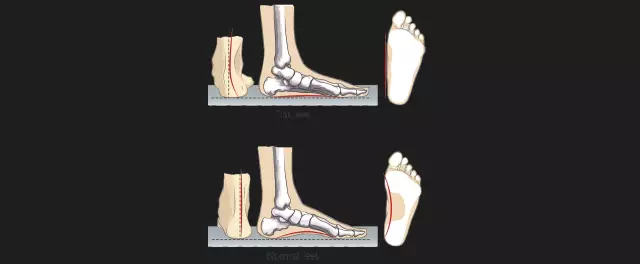- Author Curtis Blomfield [email protected].
- Public 2023-12-16 20:44.
- Last modified 2025-01-23 17:01.
According to statistics, every tenth inhabitant of our planet suffers from foot fungus or, as it is also called, epidermophytosis. Most often, men suffer from this disease, which is more due not so much to physiological features as to the fact that males wear closed shoes more often and longer than women.
Fungus on the feet: causes and risk factors

Illness can be triggered by one of the following reasons:
• insufficient hygiene of the body in general and the foot in particular;
• uncomfortable and too tight shoes;
• Excessive foot sweating;
• violations of the human immune system;
• flat feet and other foot deformities;
• use of public pools and baths;
• insufficient hygiene of bathtubs and showers;
• overweight;
• problems with blood circulation in the legs.
Common symptoms of foot fungus

Fungus on the feet can manifest itself in different ways:
• inflammation of the skin on the heels and balls of the feet;
• itching of varying severity;
• cracks;
• peeling.
Choosing the right treatment for this disease will help determine the exact type of fungus that hit the feet.
Fungus on the legs and its types
In medicine, it is customary to distinguish 3 main types of fungus: membranous, moccasin-like, vesicular. And each of them has both common and characteristic symptoms only to him.
Signs of membrane fungus:
• localization in the area of the 4th and 5th toes;
• scaly characteristic of most types of fungus;
• itchy.
Moccasin-like fungus on the feet is different from the others:

• thickening of the soles of the feet;
• deeper cracks;
• painful sensation;
• damage to nails, which, like the skin of the feet, thicken, acquiring at the same time excessive fragility that can even lead to loss of the nail plate.
Vesicular fungus is characterized by:
• fluid-filled blisters;
• localization on the bottom of the foot.
Fungus on the feet: diagnosis
The diagnosis of foot fungus is made by a dermatologist based on a patient's examination. More detailed studies: scrapings, skin biopsy, cultivation - will help the doctor determine as accurately as possible the type of fungus that struck the patient. In addition to everything, the doctor conducts a survey of the patient regarding the manifestation of this disease in the past. The latter is especially important, since often recurrent manifestations of the fungus over a certain period of time sign althe transition of the disease into a more severe form, which is more difficult to treat.
How to treat foot fungus?
Treatment of foot fungus does not require inpatient supervision and is carried out on an outpatient basis. In most cases, the patient is prescribed external antifungal drugs (Miconazole, Tinakitin and others). It should be noted that often people suffering from foot fungus do not go to a specialist at all, limiting themselves to taking drugs sold in pharmacies without a prescription. This scenario often leads to a favorable outcome of the disease. However, it should be remembered that long-term therapy of the disease, accompanied by a deterioration in the condition of the legs, indicates an advanced stage of the disease. The best way out of this situation is to visit a specialist who will help you choose the best remedy for foot fungus.






